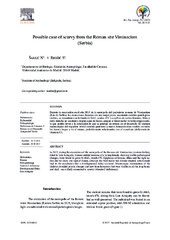Приказ основних података о документу
Possible case of scurvy from the Roman site Viminacium (Serbia)
| dc.creator | Šarkić, Nataša | |
| dc.creator | Redžić, Saša | |
| dc.date.accessioned | 2023-10-04T14:02:12Z | |
| dc.date.available | 2023-10-04T14:02:12Z | |
| dc.date.issued | 2017 | |
| dc.identifier.issn | 2253-9921 | |
| dc.identifier.uri | http://rai.ai.ac.rs/handle/123456789/615 | |
| dc.description.abstract | In 2015, during the excavation of the necropolis of the Roman site Viminacium (eastern Serbia), dated to Late Antiquity, human skeletal remains of a young female, showing visible pathological changes, were found in grave G-5663, trench 478. Epiphyses of femurs, tibias and the right radius did not show any sign of fusion, although the third molar had already erupted, which could lead to the conclusion that a developmental delay occurred. Macroscopic examination of the skeleton revealed porotic changes and new bone formation that were visible on all the long bones and skull - most likely connected to scurvy (vitamin C deficiency). | sr |
| dc.language.iso | en | sr |
| dc.publisher | Sociedad Española de Antropología Física | sr |
| dc.rights | openAccess | sr |
| dc.source | Revista Española de Antropología Física (REAF) | sr |
| dc.subject | Malnutrition | sr |
| dc.subject | Disease | sr |
| dc.subject | Paleopathology | sr |
| dc.subject | Vitamin C deficiency | |
| dc.subject | Developmental Delay | |
| dc.subject | Late Antiquity | |
| dc.title | Possible case of scurvy from the Roman site Viminacium (Serbia) | sr |
| dc.type | article | sr |
| dc.rights.license | ARR | sr |
| dc.citation.epage | 18 | |
| dc.citation.spage | 9 | |
| dc.identifier.fulltext | http://rai.ai.ac.rs/bitstream/id/2638/bitstream_2638.pdf | |
| dc.identifier.rcub | https://hdl.handle.net/21.15107/rcub_rai_615 | |
| dc.type.version | publishedVersion | sr |


